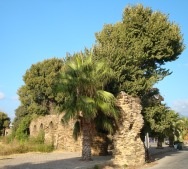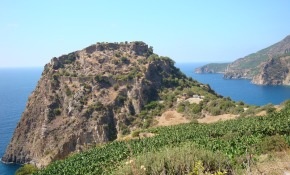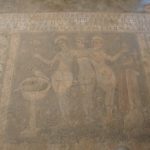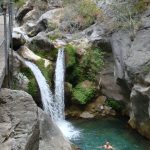Atatürk’s town Population: 24,200
Old name: Selinus, Trajanapolis
Market days: Monday (textiles), Friday (fruit & veg)
Once you leave Alanya on Turkey’s south coast the road east becomes increasingly wild and rolling. There is one last place due east of Alanya that you might want to stop at and that is the small beach resort of Gazipaşa.
Actually, the beach is not obvious when you first arrive in town. Once you find it it’s a pleasant enough strip of sand with, at the west end (Kızılin Beach) some beautiful red rocks slipping down into the sea. There are several small cafes along the beach including a popular one affiliated with the local Öğretmen Evi and another, at the eastern end, owned by the Belediye and equipped with BBQ units.
Within Gazipaşa itself you will see the remains of an old aqueduct sliced in half by the road. At the eastern end of the beach the ruins of Roman Selinus sit astride a steep-sided rock. It was here that the Emperor Trajan died in 117. The remains of a castle on the acropolis survive, along with a cistern and traces of a church dedicated to St Thekla.
Antioch ad Cragum

The town’s main attraction lies just outside to the east around the village of Güney where the remains of Antioch ad Cragum (AKA Güney Kalesi) lie scattered across a spectacularly beautiful stretch of coast land with a castle astride a plug of rock surrounded by sea of the deepest lapis lazuli. The hillsides all around are thick with banana plants. On a sunny day it would be hard to imagine anything finer.
Excavations have uncovered the largest Roman mosaic in southern Turkey as well as the remains of a gate with rutted paving stones, and of a temple probably dedicated to Venus with a vat for making wine dug into the rock beside it.
The site caretaker will point out the carved details on the collection of stones near the temple; you’ll see a spotty dog, a crab and a tortoise as well as a roundel supported by two angels. But the ruins obviously cover a vast area – the ground is littered with toppled columns – so much more work awaits the archaeologists.

Backstory of Antioch ad Cragum
The city was founded by King Antiochus IV Epiphanes in c. 170 BC and is thus of Hellenistic origin although recent discoveries suggest it eventually became typically Roman. Later it was the seat of a Byzantine bishopric before becoming part of the kingdom of Lesser Armenia. In 1332 it was seized by the Knights Hospitaller.
Sleeping
Gazipaşa does have a few hotels and pensions but not much that’s either outstanding or in the best of locations. One option is to stay at the large new Öğretmen Evi (Teacher’s House, Yıldız Sokak No 6, Tel: 0242-572 4283) where rooms come with smart bathrooms and Internet access. Prices are low for what’s on offer. To find it look for the Akdeniz Restaurant on the main street – it’s just behind it.
Of the existing hotels, perhaps the best is the Baysal Apart Otel (Tel: 0242-572 1905) midway between the centre and the beach, near the aqueduct. 
Transport info
The airport just west of Gazipaşa almost inevitably means that the town will expand in the future.
There are regular buses from Silifke and Antalya/Alanya to Gazipaşa as well as more frequent minibuses from Alanya town centre.
Day trip destinations


